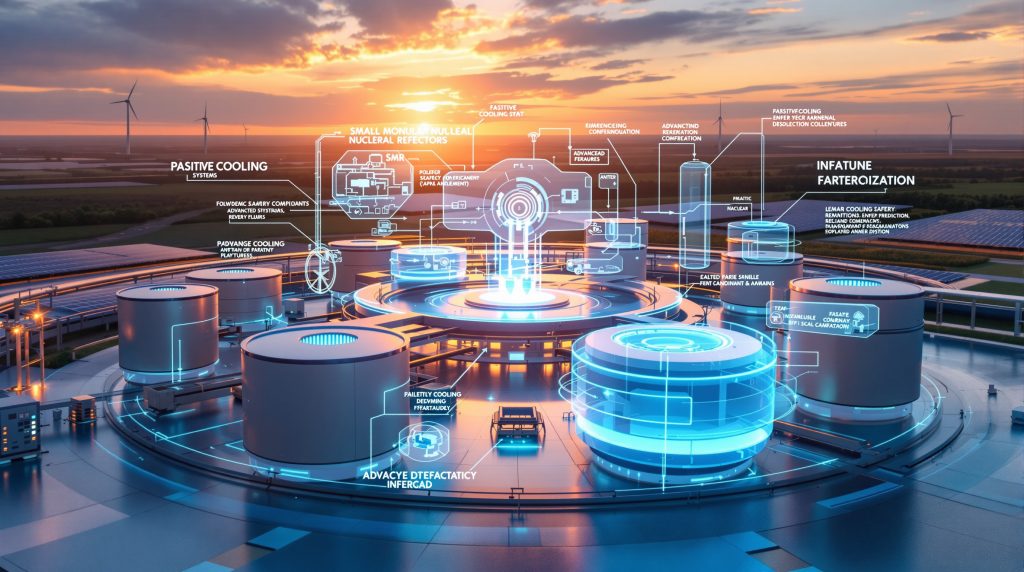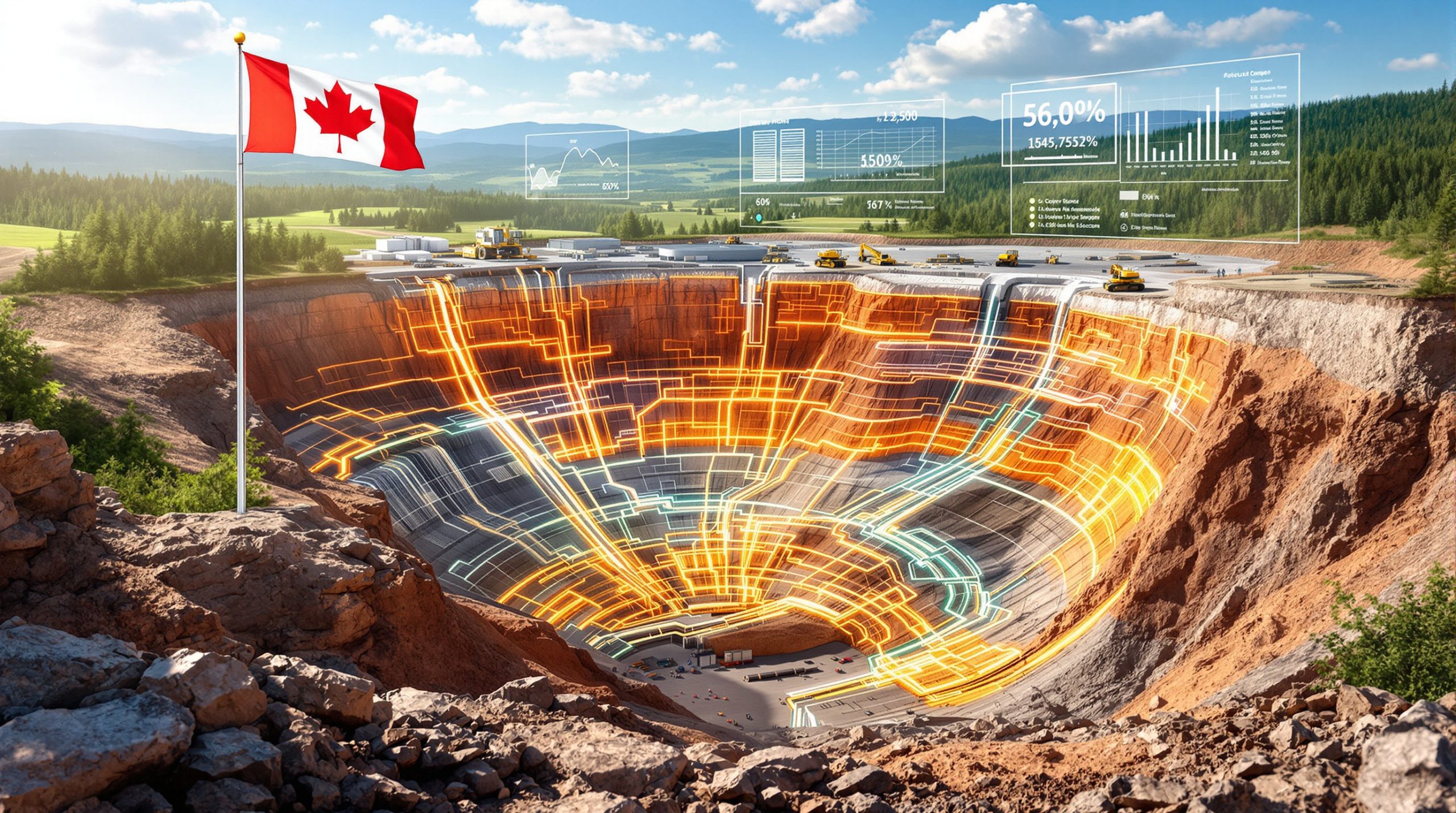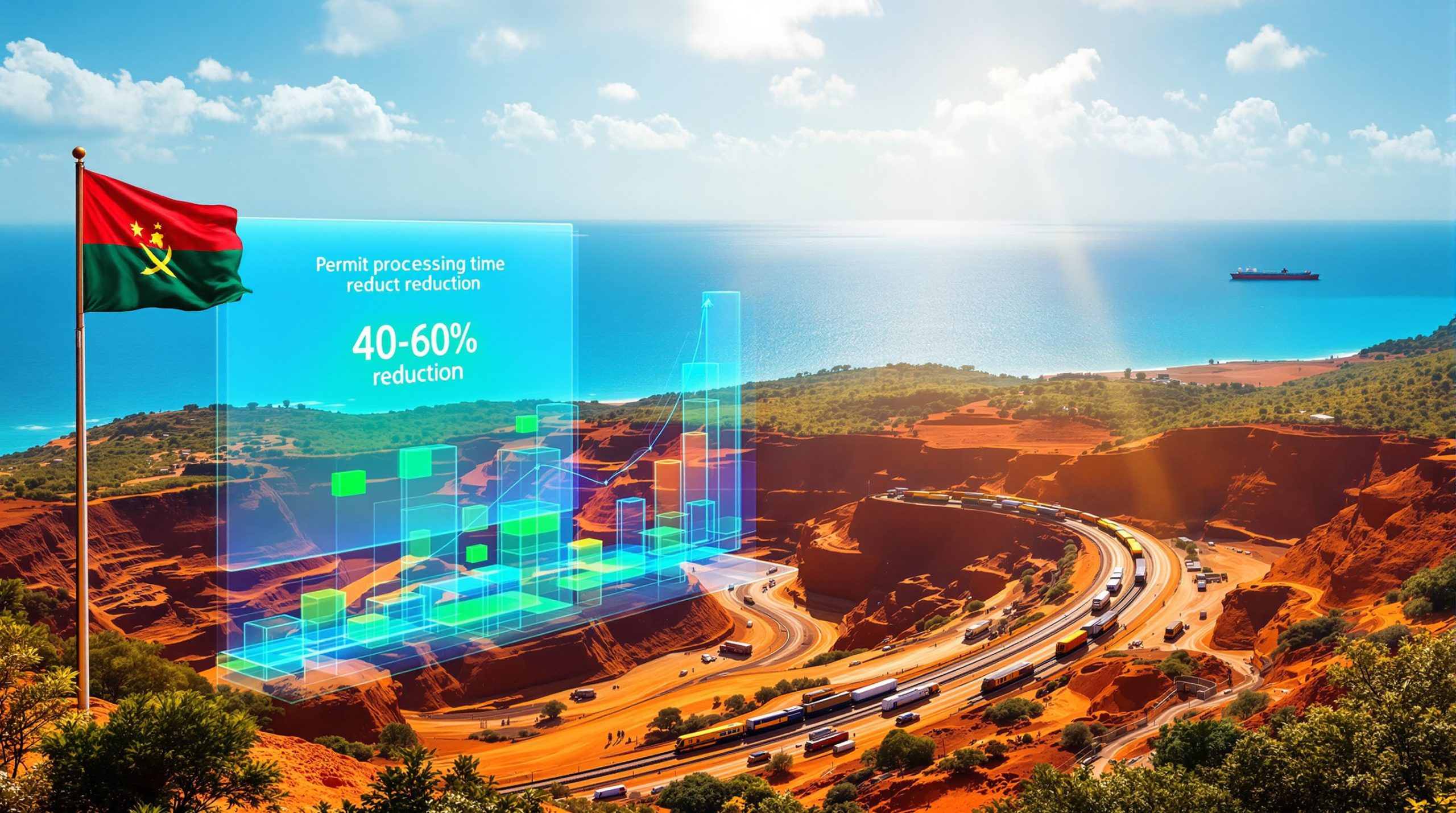What Are Small Modular Reactors and Why Do They Matter?
Small Modular Reactors (SMRs) represent an innovative approach to nuclear power generation, designed with capacities up to 300 megawatts electric (MWe) per unit—roughly one-third the size of conventional nuclear reactors. Unlike their larger counterparts, SMRs are engineered for factory fabrication as complete modular units that can be transported to installation sites, offering a streamlined construction process that transforms how nuclear energy can be deployed.
These compact nuclear solutions provide several key advantages over traditional nuclear plants. Their reduced physical footprint allows installation in locations unsuitable for conventional reactors. The factory-based manufacturing ensures higher quality control and standardization, while their scalable design enables capacity expansion by adding modules as energy demands grow. Perhaps most importantly for investors and utilities, SMRs require lower upfront capital compared to traditional nuclear facilities.
Defining the SMR Revolution
The fundamental difference between SMRs and conventional nuclear plants extends beyond just size. While traditional reactors typically exceed 1,000 MWe per unit and require extensive on-site construction over 7-10+ years, SMRs can be deployed in an estimated 3-5 years through their modular approach.
This modular design significantly transforms nuclear economics. Rather than committing to massive single-unit projects with enormous upfront costs, utilities and energy companies can add capacity incrementally, reducing financial risk and matching generation capacity to actual demand growth.
| Feature | Small Modular Reactors | Traditional Nuclear Plants |
|---|---|---|
| Power Output | 5-300 MWe per unit | 1,000+ MWe per unit |
| Construction | Factory-built modules | On-site construction |
| Deployment Time | 3-5 years (estimated) | 7-10+ years |
| Financing | Lower initial investment | Massive upfront capital |
| Safety Systems | Often passive, gravity-based | Typically active, power-dependent |
| Siting Flexibility | Can serve remote areas, industrial sites | Requires major grid connection |
The Strategic Importance of SMRs Today
The growing interest in small modular reactors stems from several converging factors reshaping global energy priorities. With increasing urgency to decarbonize electricity generation while maintaining grid reliability, SMRs offer a compelling solution that provides baseload power without carbon emissions.
Recent geopolitical tensions have highlighted the importance of energy independence, positioning SMRs as strategic assets for countries seeking to reduce reliance on imported fuels. This strategic value has attracted attention from unexpected quarters—at a recent World Nuclear Association symposium, industry leaders noted Microsoft's decision to join the WNA, a move that would have been "unthinkable" just three years ago.
The shift in perception has been remarkable. As one industry expert observed during the symposium, the conversation around SMRs has evolved rapidly from "maybe they're coming" to "here's the evidence they will be a substantial part of our future."
Note: While nuclear power faces historical perception challenges, the involvement of major technology companies signals a significant shift in how SMRs are viewed as essential components of future energy strategies.
How Do SMRs Transform Nuclear Power Economics?
The economic case for SMRs centers on different advantages than traditional nuclear plants, focusing on flexibility, reduced risk, and new deployment models rather than pure economies of scale.
Breaking Down the Financial Barriers
While SMRs may not achieve the economies of scale of larger reactors on a per-megawatt basis, they offer significant advantages in terms of financing structure and risk profile:
- Reduced financing costs due to shorter construction periods (3-5 years versus 7-10+ for conventional plants)
- Lower total project risk with smaller individual investments
- Incremental capacity additions matching demand growth
- Improved cash flow dynamics with earlier revenue generation
This financial model aligns better with current market realities where utilities and power companies face uncertainty about long-term demand growth and struggle to justify multi-billion dollar commitments to single projects.
The Manufacturing Advantage
The factory production model for SMRs represents a fundamental shift from the traditional custom-built approach of conventional nuclear plants:
- Learning curve benefits reducing costs with each additional unit manufactured
- Quality control improvements through standardized production processes
- Supply chain efficiencies with consistent component specifications
- Workforce development focusing on repeatable manufacturing skills
This manufacturing approach mirrors successful models from other industries where initial units carry higher costs, but subsequent production achieves significant efficiencies. Industry experts at the WNA symposium noted that the "hockey stick" deployment curve projected for SMRs reflects this manufacturing logic—slow initial growth followed by rapid acceleration as production systems mature.
What Makes SMRs Safer Than Traditional Nuclear Plants?
Safety innovations represent one of the most significant advancements in SMR design philosophy compared to conventional nuclear plants, addressing historical concerns about nuclear energy through fundamental design changes.
Advanced Passive Safety Systems
Many SMR designs incorporate passive safety features that operate without requiring active intervention, external power, or operator actions:
- Natural circulation cooling that removes decay heat even during complete power loss
- Lower power density reducing the rate of temperature increase during abnormal conditions
- Smaller core inventories limiting the potential release of radioactive materials
- Underground siting options providing additional physical protection
These passive safety systems function based on natural physics—such as gravity, natural circulation, and convection—rather than requiring pumps, backup generators, or other active components that could fail during emergencies.
Operational Simplification
The smaller scale and integrated design of SMRs often result in fewer components and systems to monitor and maintain. This simplification can reduce operational complexity and the potential for human error—a significant factor in historical nuclear incidents.
As noted by industry experts, nuclear engineers traditionally prefer "absolute certainty" in operations—a culture that can sometimes slow innovation. However, SMR designs incorporate this cultural emphasis on safety while introducing simplified approaches that reduce complexity.
Some SMR designs also feature extended operating cycles between refueling, reducing the frequency of operations that could introduce human error. This combination of passive safety features and simplified operations addresses many of the concerns associated with conventional nuclear plants.
Which Industries and Applications Will Drive SMR Adoption?
The market for SMRs extends beyond traditional utility power generation, with several distinct sectors emerging as key drivers for adoption.
The Data Center Revolution
The exploding energy demands of data centers and cloud computing facilities have created a new market opportunity for SMRs that would have been unimaginable just a few years ago:
- Hyperscalers (Amazon, Microsoft, Google) facing enormous power requirements for AI and cloud services
- Dedicated power arrangements through "behind-the-meter" deployments
- Carbon-free reliability essential for companies with climate commitments
Microsoft's recent joining of the World Nuclear Association signals this shift—a move that industry experts at the WNA symposium noted would have been "unthinkable three years ago." This corporate interest extends beyond just purchasing power to actively shaping the future deployment of nuclear technology.
The data center sector's involvement is particularly significant because these companies bring both massive capital resources and a technology-forward mindset that can accelerate SMR development and deployment.
Industrial Applications Beyond Electricity
SMRs offer unique capabilities for industrial applications requiring both electricity and process heat:
- Manufacturing facilities needing reliable power and steam
- Chemical production using high-temperature process heat
- Hydrogen production for transportation and industrial feedstocks
- Water desalination in coastal regions facing freshwater shortages
These combined heat and power applications can significantly improve the economics of SMR projects by providing multiple revenue streams from a single facility. The ability to co-locate SMRs with industrial facilities also minimizes transmission losses and infrastructure costs.
Grid Support and Fossil Replacement
A third significant market segment involves replacing retiring fossil fuel plants while maintaining grid stability:
- Coal plant repurposing utilizing existing grid connections and cooling water resources
- Grid stability services supporting intermittent renewable generation
- Remote community power replacing diesel generators in isolated areas
This application has particular appeal for utilities facing the retirement of aging coal plants while needing to maintain reliable generation capacity. The smaller size of SMRs allows more flexible siting than conventional nuclear plants, potentially enabling direct replacement of smaller coal units while reusing existing infrastructure.
What Does the Global SMR Development Landscape Look Like?
The race to commercialize SMR technology has become increasingly global, with several countries making significant investments and achieving important milestones.
North American Leadership
The United States has positioned itself as a leader in SMR development through several initiatives:
- The Department of Energy's Advanced Reactor Demonstration Program supporting multiple designs
- NuScale Power's achievement as the first SMR design to receive certification from the Nuclear Regulatory Commission
- Strategic partnerships between technology companies and nuclear developers
- Recent executive orders streamlining regulatory processes for military site deployments
As highlighted at the recent WNA symposium, companies like Fermy are developing plans to build both SMRs and AP-1000 reactors within U.S. military sites, leveraging executive orders that grant jurisdictional regulatory control to the Department of Defense. This approach bypasses some of the regulatory challenges that have slowed nuclear development in the commercial sector.
Canada has also emerged as a leader, with plans to build the first SMR in the Western world at the Darlington site, establishing important precedents for licensing and construction.
International Competition and Collaboration
Several other countries have made significant progress in SMR development:
- China: Successfully connected the world's first commercial land-based SMR (the HTR-PM high-temperature gas-cooled reactor) to the grid
- Russia: Operates the Akademik Lomonosov floating nuclear power plant in remote Siberia, providing valuable operational experience
- United Kingdom: Created a supportive environment for SMR development with government funding for multiple SMR design concepts
Industry experts note that Russia's floating nuclear plant has been "on the water, plugged into the grid for years now" in Chukotka, remote Siberia, demonstrating the practical viability of small reactor technology in challenging environments.
This international competition has accelerated development timelines while also creating opportunities for knowledge sharing and collaborative approaches to regulation and safety standards.
How Will SMRs Impact Uranium Markets and Fuel Cycles?
The potential large-scale deployment of SMRs has significant implications for uranium market dynamics and nuclear fuel cycles, potentially transforming supply-demand dynamics over the coming decades.
Projected Demand Growth
Industry forecasts for SMR deployment show remarkable growth potential over the coming decades:
- The World Nuclear Association's recent nuclear fuel report projects approximately 110 gigawatts of SMR capacity deployed globally by 2040 in its upper scenario
- A study commissioned by Urenco—a major nuclear fuel cycle company—suggests that if the industry effectively addresses supply chain and regulatory challenges, SMR deployment could reach approximately 700 gigawatts by 2050
- This represents substantial growth from the current installed base of approximately 7 gigawatts of small reactor capacity worldwide
This growth curve follows a classic "hockey stick" pattern, with accelerating deployment rates as the technology matures and economies of scale develop. As noted by industry experts, this trajectory means "we need to be exploring now and making discoveries now for the fuel that's going to go into those SMRs in 2050."
Advanced Fuel Requirements
Many SMR designs incorporate innovations in fuel utilization that differ from conventional reactors:
- Higher enrichment levels (HALEU – High-Assay Low-Enriched Uranium) enabling longer operating cycles
- Advanced fuel designs improving efficiency and safety margins
- Novel fuel cycles potentially utilizing thorium or recycled materials
These fuel requirements create both challenges and opportunities. The need for HALEU (uranium enriched between 5-20% U-235, compared to the 3-5% used in conventional reactors) will require significant expansion of enrichment capacity. However, it also creates opportunities for new fuel cycle facilities and technologies.
The projected growth in uranium demand from SMRs highlights potential supply challenges that will require addressing soon. Current uranium mining update efforts are crucial, as new mine development typically requires 7-10+ years from discovery to production.
What Challenges Must SMRs Overcome for Widespread Adoption?
Despite growing momentum, several significant challenges must be addressed before SMRs can achieve their full potential.
Regulatory Hurdles and Harmonization
The international nature of SMR development creates challenges for regulatory approval:
- Different national requirements complicate standardized designs
- First-of-a-kind licensing processes remain lengthy and expensive
- Regulatory frameworks designed for large reactors may not align with SMR characteristics
Some innovative approaches are emerging to address these challenges. As highlighted in industry discussions, the use of military sites with Department of Defense jurisdiction provides one pathway to streamline deployment in the US, bypassing some of the Nuclear Regulatory Commission processes that have slowed commercial development.
Efforts toward international harmonization of standards are underway, but progress remains slow. The success of early deployments in establishing regulatory precedents will be crucial for accelerating later projects.
Supply Chain Development
The manufacturing infrastructure required for mass production of SMRs differs substantially from that used for conventional nuclear plants:
- Precision manufacturing capabilities for standardized components
- Quality assurance systems appropriate for nuclear-grade fabrication
- Workforce development to support specialized production processes
- Materials supply for specialized SMR components
Building this specialized supply chain requires significant investment before large-scale deployment can begin. The industry faces a classic "chicken and egg" problem—manufacturers hesitate to invest without guaranteed orders, while developers struggle to place orders without an established supply chain.
Public Acceptance and Education
Nuclear technology continues to face public perception challenges:
- Historical accidents shape public opinion despite technological advances
- Education about passive safety features remains limited
- Local community engagement is essential for successful deployment
The growing involvement of technology companies and the pressing need for carbon-free energy are helping shift public perception, but proactive communication and education efforts remain essential for SMR deployment.
What's the Timeline for Commercial SMR Deployment?
Understanding the likely timeline for SMR deployment is crucial for investors, policymakers, and energy planners considering the role of this technology in future energy systems.
Near-Term Milestones (2023-2030)
Several important SMR projects are expected to reach significant milestones in this decade:
- First Western SMR at Darlington, Canada (scheduled for 2028)
- NuScale's first commercial deployment at the Idaho National Laboratory
- Additional deployments of Russian floating SMRs
- Expansion of China's HTR-PM program
These first-of-a-kind projects will establish important precedents for licensing, construction, and operations that will influence subsequent deployments. As noted by industry experts, these early projects face significant challenges as "nuclear engineers prefer absolute certainty," making first deployments particularly challenging.
The experience gained from these early projects will be crucial for improving designs, streamlining regulatory processes, and optimizing construction techniques for later deployments.
Mid-Term Growth (2030-2040)
The 2030s are expected to see accelerating deployment as early projects demonstrate success:
- Standardized designs receiving regulatory approval in multiple countries
- Manufacturing capacity expanding to support multiple simultaneous projects
- Growing acceptance of SMRs for grid support and industrial applications
The World Nuclear Association's projection of 110 gigawatts of SMR capacity by 2040 suggests significant growth during this period, with deployment rates accelerating toward the end of the decade as supply chains mature and regulatory pathways become established.
Long-Term Potential (2040-2050)
The most substantial growth is projected for the 2040s:
- Mature manufacturing capabilities enabling rapid deployment
- Multiple standardized designs available for different applications
- Integration with hydrogen production and other advanced energy systems
The Urenco study's projection of 700 gigawatts by 2050 represents a massive scaling of the technology during this period, enabled by the experience and infrastructure developed in earlier phases.
This "hockey stick" deployment curve is typical for new energy technologies, which often experience slow initial growth followed by rapid acceleration as costs decrease and deployment barriers are overcome.
Frequently Asked Questions About SMRs
Are SMRs Commercially Available Today?
A limited number of SMR designs have achieved commercial operation:
- Russia's floating KLT-40S reactors on the Akademik Lomonosov in Chukotka, Siberia
- China's HTR-PM high-temperature gas-cooled reactor
- Several additional designs are in advanced stages of licensing and construction
However, most SMR designs remain in development, with first commercial deployments expected in the late 2020s and early 2030s.
How Long Does It Take To Build An SMR?
Construction timelines vary by design, but most developers target:
- 24-36 months for construction of initial units
- Potential reduction to 18-24 months for subsequent units as manufacturing experience accumulates
- Total project timelines of 3-5 years from final investment decision to commercial operation
These timelines compare favorably to the 7-10+ years typically required for conventional nuclear plants, though early projects may face delays as first-of-a-kind challenges are addressed.
Do SMRs Use Different Fuel Than Traditional Nuclear Plants?
Fuel requirements vary by design:
- Many SMR designs use conventional low-enriched uranium similar to existing plants
- Some advanced designs require High-Assay Low-Enriched Uranium (HALEU) with enrichment levels between 5-20%
- A few innovative concepts explore thorium fuel cycles or other alternative approaches
The fuel requirements for different SMR designs have important implications for fuel cycle facilities and uranium markets, particularly the need for expanded HALEU production capabilities. The development of U.S. uranium production capabilities will be crucial for meeting these needs.
Can SMRs Help Address Climate Change?
SMRs offer several potential contributions to climate goals:
- Carbon-free electricity generation with high reliability
- Potential replacement for retiring coal and natural gas plants
- Support for grid stability as renewable penetration increases
- Process heat for industrial decarbonization
The ability of SMRs to provide both electricity and process heat makes them particularly valuable for hard-to-decarbonize sectors like heavy industry and chemical production. Furthermore, their role in energy transition trends is becoming increasingly recognized by climate experts.
Conclusion: The Future of Nuclear Energy
Small Modular Reactors represent a significant evolution in nuclear technology, offering potential solutions to many of the challenges that have limited nuclear power's role in clean energy transitions. Their smaller size, enhanced safety features, flexible deployment options, and improved economics create opportunities for nuclear energy in applications beyond traditional large baseload plants.
While significant challenges remain—including regulatory hurdles, supply chain development, and public acceptance—the growing interest from technology companies, utilities, and governments worldwide suggests momentum is building behind SMR deployment. The next decade will be crucial in determining whether SMRs can fulfill their promise as a major component of future clean energy systems.
For investors, utilities, and policymakers, understanding the evolving SMR landscape will be essential for navigating the energy transition and capitalizing on the opportunities created by this innovative approach to nuclear power. Recent concerns about U.S. uranium disruption highlight the importance of developing robust domestic supply chains to support this emerging technology.
To learn more about the technical aspects of small modular reactors, the International Atomic Energy Agency provides comprehensive information on their design, safety features, and regulatory considerations. For those interested in the Australian context, ANSTO offers an overview of how SMRs might fit into the country's energy future.
Ready to Spot the Next Major Mineral Discovery?
Stay ahead of the market with Discovery Alert's proprietary Discovery IQ model that provides real-time notifications when significant ASX mineral discoveries are announced. Visit our discoveries page to understand why historic mineral discoveries have generated substantial returns for early investors.




